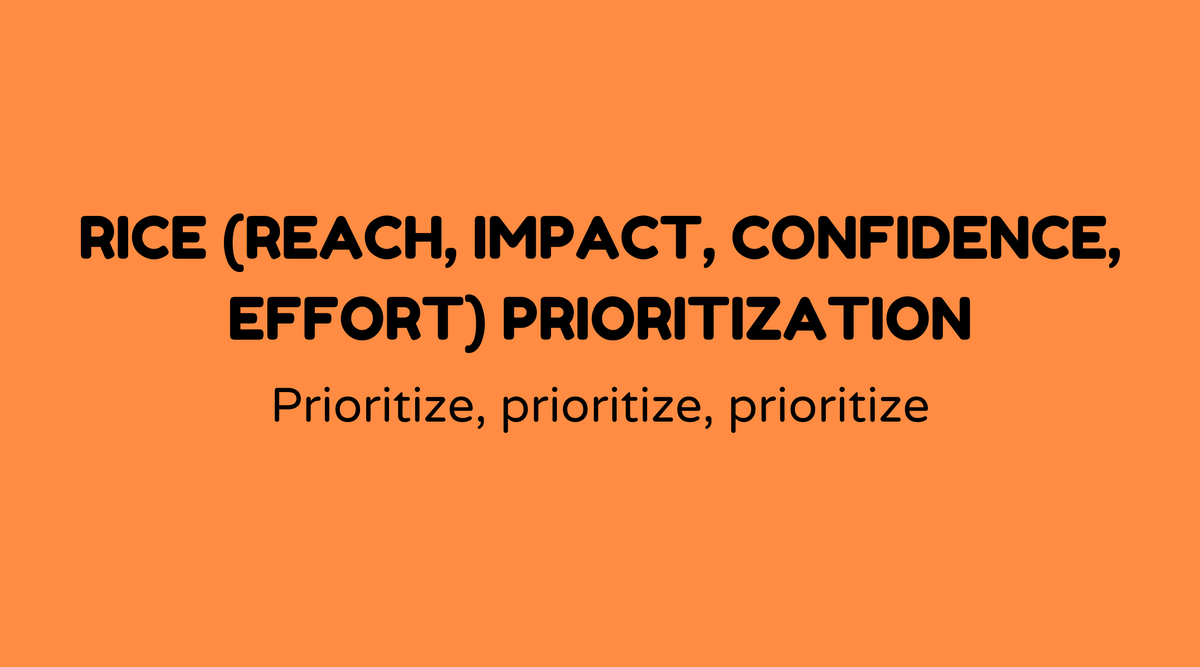RICE (Reach, Impact, Confidence, Effort) Prioritization

Overview of RICE (Reach, Impact, Confidence, Effort) Prioritization Workshop:
Navigating through numerous ideas and projects can be daunting. Enter the RICE prioritization method—a practical framework to prioritize based on four essential elements: Reach, Impact, Confidence, and Effort. At a RICE Prioritization Workshop, you'll gain experience applying this model, organizing scattered thoughts into a clear plan, ensuring you stay on track.
Why RICE Prioritization Workshop Matters:
Have you ever faced a multitude of ideas without a clear priority? That's where a RICE workshop excels, as it assists teams and individuals in concentrating on what truly matters. Effective prioritization results in quicker decisions, strategic alignment, and, most importantly, clarity on what delivers the most value. By grasping each element in the RICE model, you’re equipped to make informed choices and optimize your resources.
What is RICE (Reach, Impact, Confidence, Effort):
Let’s break down those components:
- Reach: How many users will an initiative potentially influence? Quantify it over a specific timeframe.
- Impact: Rate the degree of change this initiative generates on a scale (e.g., 0.25 to 3).
- Confidence: Assess how assured you are regarding your impact and reach estimates.
- Effort: Calculate the work input required, often measured in "person-months" or days.
In essence, RICE is a scoring system to assess the importance of each project or initiative, simplifying prioritization.
How to Conduct a RICE Prioritization Workshop:
Ready to host your own workshop? First, gather all stakeholders, as diverse perspectives enrich the discussion. Start by listing all potential projects or tasks. Then, brain dump all critical elements: Reach, Impact, Confidence, and Effort for each project. Assign scores based on your insights into each component. Calculate your RICE score—higher scores indicate higher priority.
Sample Agenda of RICE Prioritization Workshop:
-
Introduction (10 mins)
- Welcome participants
- Brief overview of the RICE model
-
Listing Projects (20 mins)
- Brainstorm all possible initiatives
-
Scoring Session (30 mins)
- Assess Reach, Impact, Confidence, and Effort for each initiative
- Group discussion for alignment
-
Calculation and Ranking (20 mins)
- Determine RICE score
- Rank priorities accordingly
-
Discussion (30 mins)
- Share findings and insights
- Address any questions or uncertainties
-
Conclusion (10 mins)
- Recap and outline the next steps
Examples of RICE Prioritization Workshop:
Imagine you're involved in a startup aimed at increasing user engagement. You have several options: launch a social media campaign, improve UX design, or introduce a referral program. By participating in or facilitating a RICE workshop, you determine that enhancing UX design has the greatest reach and high impact with less effort, leading to its prioritization over launching a new campaign.
FAQs
What is the RICE prioritization method used for?
It's utilized to prioritize product features, projects, or initiatives by balancing factors influencing project success and feasibility.
How do I score using the RICE framework?
Evaluate and assign numerical values to reach (number affected), impact (degree of change), confidence (certainty level), and effort (input required).
Can RICE be used outside tech or product management?
Certainly! RICE is adaptable and can be applied in any field where prioritization is critical, such as marketing, non-profits, or education.
How do you calculate a RICE score?
Multiply your reach, impact, and confidence scores, then divide by effort. The formula: (R * I * C) / E.
RICE vs other prioritization models—what's the difference?
RICE is data-driven, emphasizing quantitative aspects, unlike models like MoSCoW that focus on qualitative evaluation.
What’s considered a good RICE score?
It varies depending on the context, but higher scores generally suggest a more favorable balance of high impact, confidence, and reach versus effort.



